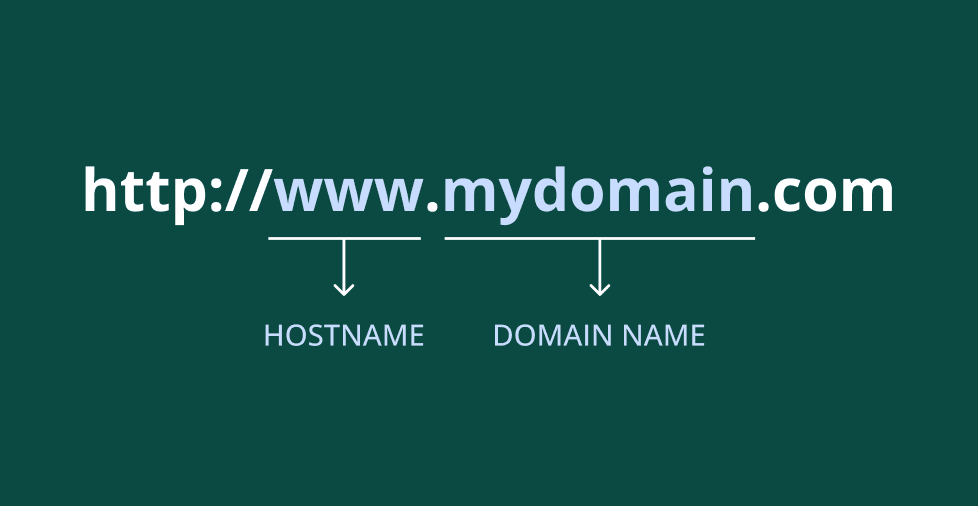Key takeaways:
- A hostname is a label that identifies a specific device, such as a computer or printer, on a local network.
- A domain name is your website’s user-friendly address that helps people easily find your site online.
- While hostnames organize devices within a local space, domain names connect you to the global internet. You can freely assign a hostname, but you need to register a domain name for your website.
- A Fully Qualified Domain Name (FQDN) brings both concepts together, acting as a complete and exact address for a specific device or service online.
Users often confuse hostnames and domain names because they’re similar in certain ways. One is that they’re both important components of the Domain Name System (DNS). Another reason is that they’re both user-friendly alternatives to complex Internet Protocol (IP) addresses.
But a hostname and a domain name serve different purposes in web development. The former is concerned with the technical aspect, while the latter relates to website branding.
In this article, we’ll explore the differences between a hostname and a domain name. We’ll also discuss what a fully qualified domain name (FQDN) is and its connection with the two terms.
What is the difference between a hostname and a domain name?
Their purpose is the main difference between a hostname and a domain name. A hostname is used to label devices, like computers, connected to the same network, while a domain name is used to access online resources, such as websites.
Think of a hostname as a name tag you give your computer, while a domain name is your house address. Let’s explore these terms further.
What is a hostname?
A hostname is a human-readable label assigned to devices connected to a local network or the wider internet. This name acts as a user-friendly alternative to IP addresses, which makes it easier to identify and communicate with different devices on the same network.
You can give a device any hostname you like, such as “Martins-Computer” or “Office-Printer1.”
Like the examples, hostnames should be descriptive and concise, ideally under 25 characters. They can include numbers and hyphens, too. However, avoid starting or ending them with hyphens and don’t use spaces in between.
Hostnames are particularly helpful in large organizations like office environments. For example, your company has 200 printers, but two of them are unresponsive.
With hostnames, network administrators can quickly pinpoint which two printers are unresponsive. This ensures quick troubleshooting and short downtime periods.
Multiple devices can’t share the same hostname, as this leads to confusion. Ensure to assign unique hostnames so you can identify your devices easily.
Here are different kinds of devices you can assign hostnames to:
- Computers
- Phones
- Security cameras
- Smart lightbulbs
- Smart refrigerators
Types and examples of hostnames
Hostnames typically consist of a single word or a few words with numbers that describe the device. The goal is to use specific and straightforward labels to avoid confusion.
Simple hostnames
A simple hostname identifies a device within your home Wi-Fi network. These names are usually short and easy to remember.
For instance, if you have two printers at home, you can tag them as “printer1” and “printer2.” This way, everyone in your house can easily find a particular printer on the network.
Network hostnames
Network hostnames are used for complex environments like a company’s internal network. They’re usually more specific and can include extra information about the device’s function.
An example would be naming the finance department’s printer “finance-printer.” This type of hostname helps keep things organized in bigger networks where multiple devices might serve different purposes.
What is a domain name?
A domain name is the address you type into a web browser to visit a website. It’s a simpler option than a complex IP address that computers need to interact with each other online.
How it works is that the DNS translates the domain names into their associated IP addresses. This system ensures that navigating the internet is straightforward and efficient for human users.
Read our separate article that explains in detail how domain names work.
Structure of domain names

A domain name typically contains three components, such as:
When combined, they form a unique web address that identifies a specific website. Let’s go over each one’s purpose.
Top-level domain (TLD)
The TLD is found at the end of the domain name. It basically indicates a website’s purpose or region to help visitors and search engines recognize what it’s about. For instance, the TLD of “worldwildlife.org” is “.org.”
Many kinds of TLDs exist in the DNS, including:
- Generic top-level domains (gTLDs), like .com, .net, and .org
- Country code top-level domains (ccTLDs), such as .uk for the United Kingdom or .ca for Canada
- Sponsored top-level domains (sTLDs), like .edu for educational services and .gov for government agencies
Second-level domain (SLD)
The SLD is usually the name of the brand or company that owns the site. It differentiates websites from one another within the same TLD.
For example, in “metro.com,” the name “metro” is the SLD, and in “apple.com,” the SLD is “apple”. They use the same TLD, but users and search engines can distinguish one from the other because of their SLDs.
Third-level domain (Subdomain)
The subdomain is located before the SLD and is used to separate a site into sections for different purposes.
Let’s say you want to add a dedicated space for your blog on your website, “flowers.org.” You can create the subdomain “blog.flowers.org” without building a whole new site.
Domain registration
Unlike hostnames, you need to register domain names through a domain registrar to be able to use them.
Domain registrars, like Network Solutions, are entities that manage domain name reservations. They allow users to search and purchase available domain names in the market.
When you register a domain name, you have exclusive rights to that name for a particular term so no one else can use it. Think of it like renting an apartment where the lease typically lasts for a year. You’ll need to renew it annually to continue your stay.
Other purposes of domain names
Apart from making it easy to access websites online, domain names serve other purposes, like the following:
- Establish brand identity
- Support SEO and discoverability
- Demonstrate professionalism
Establish brand identity
A domain name is an important part of your online branding and identity. It reinforces your brand and makes your website easier to find.
Support SEO and discoverability
A domain name itself doesn’t affect your search engine ranking, but its elements can be factors in your SEO performance.
A short domain name, for instance, makes it easy for users to remember your website. This then attracts organic traffic to your site and improves your visibility and engagement.
Demonstrate professionalism
Having a custom domain name conveys professionalism and trustworthiness to visitors. It also allows businesses to create branded email addresses and maintain consistency across platforms.
Hostname vs domain name: A comparison table
| Aspects | Hostname | Domain name |
|---|---|---|
| Purpose | Identifies a specific device within a network | Identifies resources on the internet |
| Example | MyPC, webserver1, admin-mail3 | google.com, amazon.com, facebook.com |
| Structure | Can consist of a single word, a group of words, and numbers | Consists of a TLD, SLD, and/or a subdomain |
| Scope | Local to a specific network | Global and unique across the internet |
| Can be used without registration? | Yes | No |
What is a Fully Qualified Domain Name (FQDN)?
A Fully Qualified Domain Name or FQDN is the full and exact address for a specific computer or resource on a network. It includes the hostname and the domain name, which together provide a unique and exact identifier within the larger DNS.
This complete address ensures each resource is uniquely pinpointed across the network.
Structure of FQDNs
Let’s discuss an FQDN’s structure to understand how it works. For this part, we’ll use “mail.nestle.com” as an example.
An FQDN is a combination of three parts:
- Hostname (the device)
- Domain name (the website or entity)
- TLD (the organization type or location type)
Hostname (the device)
This part tells you which specific device you’re trying to reach online. Using our FQDN sample above, “mail” is the label of an email server for this website.
Domain name (the website or entity)
The domain name identifies the website or the organization that owns the device you’re accessing. It’s usually related to a business or brand, like “nestle” in “mail.nestle.com.”
TLD (the organization type or location type)
The TLD is the ending part of the FQDN, like “.com” in the example we used. It gives context about the FQDN’s type of organization or location.
Why is an FQDN important?
An FQDN is important because of two reasons; it distinguishes devices from one another and makes them accessible worldwide.
Unique identification
An FQDN ensures that no two devices or services share the same address. This is to avoid confusing computer systems about where to send data.
When you type “mail.nestle.com” into your browser, you’re asking to connect specifically to the mail server for “nestle.com.” No other service or device will have that exact FQDN. This guarantees that you don’t mistakenly land on another site or service.
Global reach
The internet is a massive network connecting billions of devices and services across the globe. An FQDN makes sure that your website or service can be found anywhere in the world.
This means that users, whether they’re in New York, Bangkok, Germany, or any other country, can access an FQDN like “mail.nestle.com.”
Register your domain name with Network Solutions
While hostnames and domain names seem similar, they serve distinct roles in network management and web development.
Hostnames are mainly used to identify devices within a network or the wider internet for easier troubleshooting. Meanwhile, domain names are used to provide a user-friendly way to access websites on the internet.
Now that you understand the difference between hostnames and domain names, it’s time to begin building your online presence. Partner with Network Solutions and we’ll help you grow, just like thousands of others.
We offer an AI Domain Generator that provides several domain name suggestions that are available on the market. We also have the Domain Privacy + Protection feature that masks your personal information on the public WHOIS database.
Register your domain in minutes, not days, with Network Solutions.
Frequently asked questions
A hostname is a unique identifier for a specific device on a network, like “mycomputer.” A domain name, such as “example.com,” is a user-friendly address for websites on the internet.
A Fully Qualified Domain Name (FQDN) combines both, which gives you the complete and exact address of a device, for instance, “mycomputer.example.com.”
Yes, a hostname can be used without a domain name on a local network.
However, for a device to be accessible on the internet, it requires a domain name to provide a global, unique address. Without a domain name, a hostname has no context on the massive public internet.
Yes, you can use your domain name if you want to switch hosting providers. You’ll only need to configure your domain’s DNS settings to direct it to your new host.
Yes, you can self-host a domain name. However, this requires technical expertise and consistent maintenance. You’ll need to configure DNS settings, ensure security, and handle server uptime.
Most people use domain registrars like Network Solutions because they simplify this process and provide better reliability.




